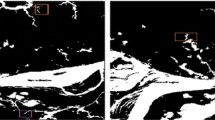Abstract
Texture classification is an important application in image processing and pattern recognition such as detection of defects on the materials and diseases from the medical images. This paper presents the performance of wave atom transform on texture classification. Wave atom transform is a new multi-resolution technique that not only captures the coherence of the pattern along the oscillations, but also the pattern across the oscillations. The classification is done using a wave atom–transformed features reduced by singular value decomposition and a support vector machine. Experimental results are presented to demonstrate the effectiveness of this approach on Brodatz database, Alzheimer’s Disease Neuro Imaging database for Alzheimer’s disease classification and liver computed tomography images for tumor classification. The experimental results demonstrate that the proposed approach gives a percent correct classification of 97.29 % on Brodatz database, classification accuracy of 94 % on Alzheimer’s Disease Neuro Imaging database for Alzheimer’s disease diagnosis and 93.3 % on liver computed tomography images for tumor classification.
Similar content being viewed by others
References
Ohanian P.P., Dubes R.C.: Performance evaluation for four classes of textural features. Pattern Recognit. 25, 819–833 (1992)
Cohen F.S., Fan Z., Attali S.: Automated inspection of textile fabrics using textural models. In: IEEE Trans. Pattern Anal. Mach. Intell. 13, 803–808 (1991)
Hong T.H., Dyer C.R., Rosenfeld A.: Texture primitive extraction using an edge-based approach. In: IEEE Trans. Syst. Man Cybern. 10, 659–675 (1980)
Azencott R., Jia-Ping W., Younes L.: Texture classification using windowed Fourier filters. In: IEEE Trans. Pattern Anal. Mach. Intell. 19, 148–153 (1997)
Chang T., Kuo J.: Texture analysis and classification with tree-structured wavelet transform. In: IEEE Trans. Image Process. 2, 429–441 (1993)
Unser M., Eden M.: Multiresolution feature extraction and selection for texture segmentation. In: IEEE Trans. Pattern Anal. Mach. Intell. 11, 717–728 (1989)
Unser M.: Texture classification and segmentation using wavelet frames. In: IEEE Trans. Image Process. 4, 1549–1560 (1995)
Choi H., Baraniuk R.: Multiscale image segmentation using wavelet-domain hidden Markov models. In: IEEE Trans. Image Process. 10, 1309–1321 (1998)
Do M.M., Vetterli M.: Wavelet-based texture retrieval using generalized Gaussian density and Kullback–Leibler distance. In: IEEE Trans. Image Process. 11, 146–158 (2002)
Wouwer G.V., Scheunders P., Dyck D.V.: Statistical texture characterization from discrete wavelet representations. In: IEEE Trans. Image Process. 8, 592–598 (1999)
Chen L., Man H.: Hybrid IMM/SVM approach for wavelet-domain probabilistic model based texture classification. IEE Proc. Vis. Image Signal Process. 152, 724–730 (2005)
Selvan S., Ramakrishnan S.: SVD-based modeling for image texture classification using wavelet transformation. In: IEEE Trans. Image Process. 16, 2688–2696 (2007)
Demanet L., Ying L.: Wave atoms and sparsity of oscillatory patterns. Appl Comput. Harmon Anal. 23, 368–387 (2007)
Brodatz P.: Textures: A Photographic Album for Artists and Designers. Dover, New York, NY (1966)
Cristianini N., Taylor J.S.: An Introduction to Support Vector Machines and other Kernel-Based Learning. Cambridge University Press, (2000)
Rajeesh J., Moni R.S., Palanikumar S., Gopalakrishnan T.: A versatile algorithm for the automatic segmentation of hippocampus based on level set. Int. J. Biomed. Eng. Technol. 7(3), 213–224 (2011)
Lao Z., Shen D., Xue Z.: Morphological classification of brains via high-dimensional shape transformations and machine learning methods. Neuroimage 21, 46–57 (2004)
Author information
Authors and Affiliations
Corresponding author
Rights and permissions
About this article
Cite this article
Rajeesh, J., Moni, R.S. & Kumar, S.S. Performance analysis of wave atom transform in texture classification. SIViP 8, 923–930 (2014). https://doi.org/10.1007/s11760-012-0337-x
Received:
Revised:
Accepted:
Published:
Issue Date:
DOI: https://doi.org/10.1007/s11760-012-0337-x




